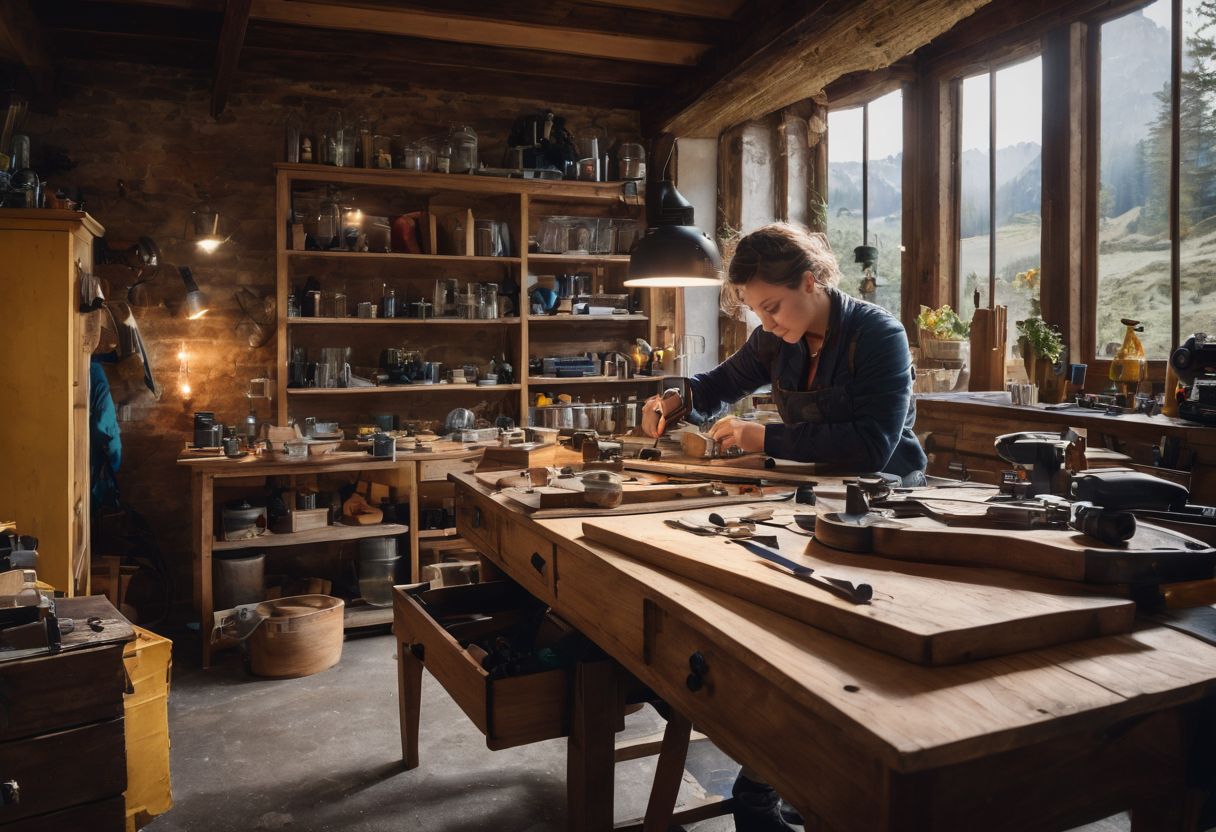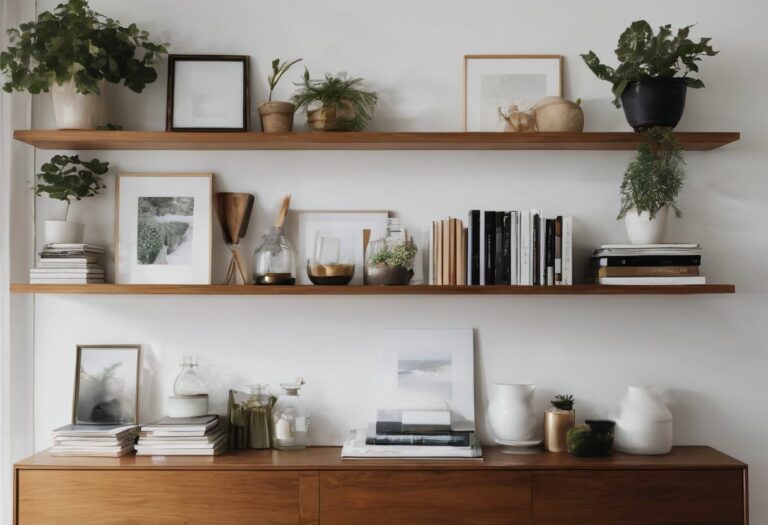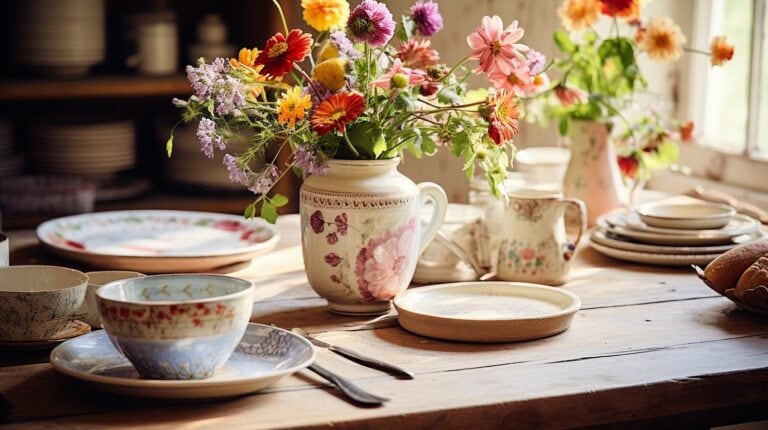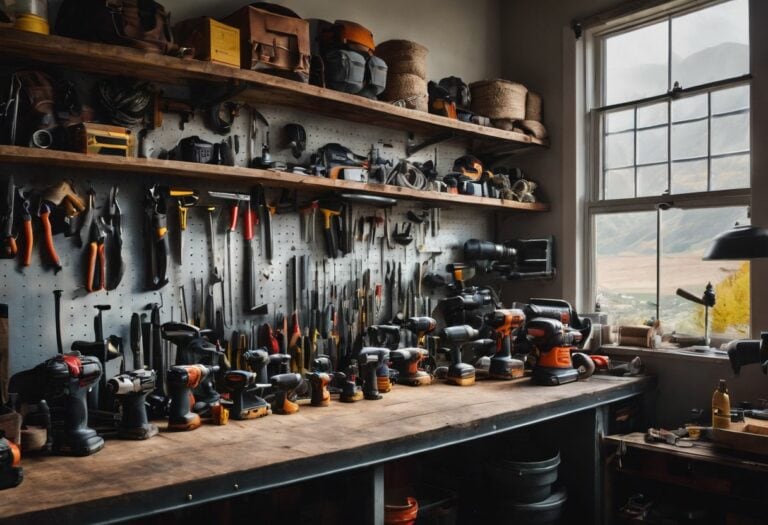Essential Toolkit Guide: What Tools Do I Need to Upcycle Furniture?
Using the right tools can make your furniture upcycling job easier and better. If you have all the necessary tools, you will not face any trouble while working. For example, a power sander is needed to sand down old paint or varnish from wooden furniture.
A good set of brushes allows for smooth and even application of new paint or finish.
Good tools also keep you safe during work. A sturdy hammer lets you remove nails without hurting yourself. Pliers give you a strong grip on small things so they don’t slip away and cause injury.
An electric detail sander helps with hard-to-reach spots that are often missed by other tools. Missed spots might show when the item is finished which does not look nice.
The choice of tool can affect how the project turns out in terms of looks and durability too! Using an effective paint sprayer can give furniture a more professional finish compared to using regular brushes.
Not having these essential items may mean less success in your DIY projects.
What Tools Do I Need to Upcycle Furniture:

For upcycling furniture, it is essential to have a set of hand tools that will help you tackle various tasks. These include pliers and wrenches for removing stubborn screws or fittings, screwdrivers for assembling and disassembling furniture pieces, utility knives for cutting materials like fabric or wallpaper, hammers for hammering nails or removing old nails, sandpaper for smoothing surfaces before painting or staining, hacksaws for cutting through metal components, and files for shaping and smoothing edges.
Pliers and Wrench
Pliers and a wrench are key tools to have in your toolkit. You will use them a lot when upcycling furniture. Pliers come in many types, but the best ones for this work are long nose pliers, flat nose pliers, and cutting pliers.
A monkey wrench is another tool you’ll need or want for your projects. It’s great at pulling out tough things that won’t budge! Also, if you need to squeeze items real tight, it can do that too.
These hand tools make fixing up old pieces easier than ever before!
Screwdriver
A screwdriver is a must-have for upcycling furniture. You use it to take out old screws and put in new ones. Be careful when you use an electric screwdriver. Do not go too fast or you might hurt the screw heads, especially with vintage flathead screws.
This simple tool helps prevent damage during your projects. With a good screwdriver, you will find it easier to work on furniture restoration tasks.
Utility Knife
Utility knives are essential tools for upcycling furniture. They are versatile cutting tools used by tradespeople and hobbyists alike. With their interchangeable blades, utility knives can handle a variety of cutting tasks.
When it comes to upcycling projects, utility knives are particularly useful for cutting lighter materials like paper or cardboard. Whether you’re trimming edges, making precise cuts, or removing excess material, a utility knife is a must-have tool in your arsenal.
Just remember to follow proper usage guidelines and precautions to ensure safety and avoid accidents or injuries during your upcycling journey.
Hammer
A hammer is a really important tool for upcycling furniture. You can use it to hammer in nails and fix joints. It’s also useful for upholstering a chair by securing the fabric in place.
With a good hammer, you’ll be able to do these tasks easily and make your furniture look great!
Sandpaper
Sandpaper is a must-have tool when you’re upcycling furniture. It’s like sanding wood, but smoother! Sandpaper helps prepare the surface of furniture before painting or refinishing it.
It removes rough edges and helps achieve a smooth finish. Good quality sandpaper lasts longer and stays sharp, so it’s worth investing in. For most furniture, medium-grit sandpaper with a grit size of around 80 works well.
But if your piece has intricate details or grooves, using finer-grit sandpaper will give you better results. And remember, sometimes you have to get hands-on and do manual sanding for corners and edges.
Hacksaw
When upcycling furniture, one essential hand tool that you’ll need is a hacksaw. A hacksaw is a handheld saw that is perfect for precision cutting during your DIY projects and furniture restoration.
It’s a versatile tool that can be used to cut through different materials, such as wood or metal. Whether you’re trimming pieces or creating new shapes, the hacksaw allows you to make accurate and clean cuts.
With its fine-toothed blade, it offers control and precision when working on your upcycling tasks. Overall, having a hacksaw in your toolbox is necessary for any upcycling project where cutting materials is involved.
File
When upcycling furniture, having a file is an essential hand tool. It helps to smooth rough edges and surfaces, making the furniture ready for painting or refinishing. By using a file, you can remove any imperfections and create a nice even finish on the wood.
Additionally, a file can be useful for shaping and contouring wood as needed. Whether it’s getting rid of sharp corners or rounding off edges, a file allows for precise adjustments to be made.
So don’t forget to add a file to your toolkit when upcycling furniture!
Essential Power Tools for Upcycling Furniture:
When it comes to upcycling furniture, having the right power tools can make a world of difference in achieving professional-looking results.
Drill
A drill is a really important power tool for upcycling furniture. It helps to make the job go faster. With a cordless drill, you can move around easily and not have to worry about being close to an outlet.
This makes it super convenient. Plus, with a drill, you can maneuver easily and work on your furniture projects without any trouble. A drill is definitely something you should have if you’re into upcycling furniture!
Electric Detail Sander
An electric detail sander is a really useful power tool for upcycling furniture. It makes the sanding process easy and hassle-free, especially in hard-to-reach areas. You’ll still need to use sandpaper with it though, as that helps to get into those tricky spots.
With an electric detail sander, you can easily remove old paint, varnish, or imperfections from the surface of your furniture. Just remember that there are different types of sanders out there, so choose one that suits your needs.
They often have a square sanding pad and move back and forth in one direction.
Jigsaw
The jigsaw is a super useful power tool for upcycling furniture. It can cut through different materials like timber, metal, and MDF, which makes it versatile for all sorts of projects.
You can use a jigsaw to create intricate patterns in your furniture or even to cut ceramic tiles if you’re feeling fancy. Makita and Ryobi are two popular brands that make great jigsaws recommended by upcyclers.
So, if you want a go-to power tool that’s versatile and perfect for cutting all kinds of materials, the jigsaw is definitely worth considering!
Paint Sprayer
A paint sprayer is a must-have tool for upcycling furniture. It allows you to quickly and evenly apply paint, giving your furniture a professional and polished look. When choosing a paint sprayer, consider features like nozzle size, portability, cup volume, and ease of cleaning and storage.
With the right paint sprayer, you can easily transform old furniture into something beautiful and unique. So if you’re looking to give your furniture a fresh new look, make sure to invest in a good quality paint sprayer.
Additional Tools for Upcycling Furniture:
In addition to the essential hand and power tools, there are a few additional tools that can make your furniture upcycling projects even easier. Find out what these tools are and how they can elevate your DIY game!
Paint Stripper
A paint stripper is an important tool when upcycling furniture. It helps to remove old coats of paint and sealer from the furniture surface. One recommended option is Citristrip, which has minimal fumes and low VOCs.
Using a carbide scraper is also recommended as the best type of paint scraper for furniture. With the help of a paint stripper, you can effectively strip wood, remove unwanted paint, and prepare your furniture for refinishing or restoring it to its former glory.
Brushes
Brushes are essential tools for upcycling furniture. They are used together with other tools to perform various tasks. Brushes can be used to apply paint stripper, stains, finishes, and paint onto furniture surfaces.
They play an important role in achieving smooth and even coverage, ensuring that the furniture looks great after the upcycling process. Brushes are often used alongside sandpaper and power sanders for surface preparation, making sure that the furniture is ready for painting or refinishing.
If you’re looking to transform your furniture through upcycling and DIY projects, brushes are a must-have tool in your toolkit.
Cloths
When upcycling furniture, having the right tools is important, and that includes additional tools for upcycling clothing. Some essential cloth-related tools include a sewing needle, cutting mat, fabric scissors, embroidery thread, iron-on transfers, fabric glue, seam ripper, tailor’s chalk, measuring tape, and a thimble.
These tools will help you make repairs or alterations to clothing pieces as part of your upcycling project. Whether you’re stitching together seams or adding decorative touches with embroidery thread, these cloth-related tools are essential for transforming old clothes into something new and unique.
Tape Measure
When upcycling furniture, having the right tools is important. While a tape measure is not mentioned in the list of essential tools, it can still be useful for measuring and ensuring accurate dimensions.
A tape measure helps you determine the length, width, and height of furniture pieces or materials that you want to upcycle. It allows you to plan your project better and make precise cuts or adjustments.
Even though some articles suggest that basic tools like an axe and saw are enough for upcycling furniture, using a tape measure can help ensure that your finished piece turns out exactly how you envisioned it.
Tool Storage
I keep my tools organized and easily accessible by using tool storage solutions. It’s important to have a designated place for each tool so that I can quickly find what I need when working on upcycling furniture projects.
I use a toolbox or a tool chest with compartments to store smaller hand tools like screwdrivers, pliers, and wrenches. For larger power tools such as drills and sanders, I have shelves or wall-mounted racks where I can hang them safely.
Keeping my tools properly stored not only saves time but also helps extend their lifespan by preventing damage or loss. With the right tool storage system in place, I can efficiently work on my upcycling projects without any hassle.
Elevate Your Upcycling and DIY Projects With These 8 Tools: Our Recommendation
Boost the quality and creativity of your upcycling and DIY projects with these 11 must-have tools from Dremel®, including the versatile Dremel® Lite, multi-functional Multi-Tool 8220, precision-based DSM20, various accessory sets, Line & Circle Cutter (678), Multi-Vise (2500), and the Multipurpose Cutting Kit (565).
1. Dremel® Lite
The Dremel® Lite is a versatile tool that can take your upcycling and DIY projects to the next level. With this multitool, you can easily sand wood, polish surfaces, and even drill holes.
It’s perfect for adding those finishing touches to your furniture pieces and giving them a professional look. The Dremel® Lite comes with video tutorials and step-by-step guides, making it easy for anyone to get started with upcycling.
So whether you’re a beginner or an experienced DIY enthusiast, the Dremel® Lite is a must-have tool in your arsenal.
2. Dremel® Multi-Tool 8220
The Dremel Multi-Tool 8220 is a versatile tool that can elevate your upcycling and DIY projects. With this tool, you can easily sand wood, polish surfaces, and even drill holes. It offers high-performance capabilities, allowing you to cut, grind, route, clean, sand, and polish various materials.
Whether you’re working with corded or cordless high-speed multitools, the Dremel 8220 is compatible with both options. It’s a popular choice among do-it-yourself enthusiasts for upcycling furniture and taking on a wide range of projects.
So if you’re looking for a reliable tool to help you tackle your upcycling endeavors with ease and precision, the Dremel Multi-Tool 8220 is definitely worth considering.
3. Dremel® DSM20
The Dremel® DSM20 is an amazing tool that can really take your upcycling and DIY projects to the next level. With its versatility, you can use it for sanding wood, polishing, and even drilling.
It’s part of the DIY/Multi-Tools category and offers endless opportunities for creativity. Whether you’re refinishing furniture or working on craft projects, the Dremel® DSM20 has got you covered.
Plus, with its 11 different tools, you’ll have everything you need to customize your creations just the way you want them. So why not give it a try and see what creative ideas it sparks for your next project?.
4. Multipurpose Set (687)
The Multipurpose Set (687) is a versatile tool set that includes 11 essential tools for upcycling and DIY projects. This assortment of tools, such as the jigsaw, drill, and detail sander, is perfect for transforming old furniture into stunning upcycled masterpieces.
With a variety of cutting and sanding tools at your disposal, this set will elevate your upcycling and DIY endeavors. It’s highly recommended for anyone looking to enhance their home renovation projects or simply tackle some creative repurposing tasks.
The Dremel Multipurpose Cutting Kit, included in this set, is especially useful for upcycling projects. Whether you’re an experienced DIY enthusiast or just starting out with upcycling furniture, the Multipurpose Set (687) is a must-have toolset that will help you achieve impressive results.
5. 150 pieces Dremel® Multipurpose Accessory Set (724)
The 150 piece Dremel Multipurpose Accessory Set (724) is a versatile and valuable addition to any DIY enthusiast’s tool collection. This set includes genuine Dremel accessories that are perfect for upcycling furniture and other projects.
It features EZ SpeedClic accessories, which make it quick and easy to change between cutting, carving, sanding, cleaning, grinding, polishing, and sharpening tasks. With this accessory set, you have everything you need to take your upcycling projects to the next level.
You can find the Dremel 724 EZ SpeedClic Accessory Set on Amazon.com.
6. Dremel® Line & Circle Cutter (678)
The Dremel Line & Circle Cutter (678) is a versatile tool that can elevate your upcycling and DIY projects. It’s one of the 11 tools mentioned in this guide for upcycling furniture.
The Dremel 678 Circle Cutter and Straight Edge Guide is an attachment for the rotary tool, making it easy to cut circles and create straight edges. You can easily attach the Dremel 678 Circle Cutter and Straight Edge Guide to your rotary tool, allowing you to make precise circular cuts and straight lines in your furniture projects.
Whether you’re cutting holes for new handles or creating intricate designs, this attachment will help you achieve professional-looking results.
7. Dremel® Multi-Vise (2500)
The Dremel Multi-Vise (2500) is an attachment for the Dremel Multi-Tool that can really elevate your upcycling and DIY projects. It’s a versatile tool that securely holds workpieces at any angle, giving you the freedom to work comfortably.
The Multi-Vise is compatible with the Dremel Rotary Tool, so you can easily switch between tools as needed. With its adjustable angles and enhanced precision, this tool provides extra control and stability when using Dremel tools.
Plus, it has a removable cushioned jaw for added protection, ensuring that your workpiece stays safe while you work. Whether you’re upcycling furniture or tackling other DIY tasks, the Dremel Multi-Vise (2500) is a valuable tool to have in your arsenal.
8. Dremel® Multipurpose Cutting Kit (565)
The Dremel® Multipurpose Cutting Kit (565) is a versatile tool that allows for controlled and precise freehand cuts of any shape. It comes with a cutting guide and various drywall cutting bits, as well as a multipurpose cutting bit.
This kit is compatible with most Dremel corded and cordless rotary tools, making it easy to achieve consistent and smooth cuts. Whether you’re creating name signs or installing fixtures, this cutting kit is an essential tool for upcycling furniture and other DIY projects.
How to Choose the Right Tools for Your Upcycling Project:
When choosing tools for your upcycling project, consider the type of furniture and materials, plan for specific tasks, and assess your budget and storage space. Find out more about selecting the right tools to enhance your upcycling experience!
Consider the type of furniture and materials
When choosing tools for upcycling furniture, it’s important to consider the type of furniture and materials you’ll be working with. Different types of furniture may require different tools or techniques for upcycling.
For example, a jigsaw can be useful for cutting intricate designs in wooden furniture, while a drill can help with removing or attaching hardware. Additionally, certain materials may require specific tools to ensure a successful upcycling project.
By considering the type of furniture and materials you’re working with, you can select the most suitable tools that will help you achieve the desired results.
Plan for specific tasks
To choose the right tools for your upcycling project, it’s important to plan for specific tasks. Consider the type of furniture you’ll be working on and the materials involved. Different projects may require different tools, so think about what you’ll need before getting started.
Assessing your budget and storage space is also crucial in determining which tools are essential for your project. By carefully planning for the specific tasks at hand, you can ensure that you have all the necessary equipment and supplies to successfully upcycle your furniture.
Don’t forget to gather everything you need before starting!
Assess your budget and storage space
Before embarking on your upcycling furniture project, it’s important to assess your budget and available storage space. This will help you make informed decisions when choosing the right tools for the job.
Consider evaluating your financial resources and determining how much you can invest in purchasing tools. Additionally, take into account the size of your storage area and whether it can accommodate larger power tools or if you need smaller hand tools that can be easily stored.
By conducting a cost analysis and considering any size constraints, you’ll be able to select the best tools that fit within your budget and storage limitations.
Upcycling Furniture Thrift Store Finds:
Evaluate potential thrift store furniture finds carefully before purchasing to ensure they are suitable for upcycling, negotiate prices with confidence, and look for unique features that can be enhanced through the upcycling process.
How to evaluate potential pieces
When looking for furniture to upcycle, it’s important to evaluate potential pieces carefully. Start by checking the overall condition of the item. Look for any major damage or structural issues that might be difficult to fix.
Consider the size and shape of the piece as well, making sure it fits your needs and space. Look for unique features or details that could be highlighted through upcycling. Lastly, assess if the materials are suitable for your project and can be easily transformed or repaired.
By evaluating potential pieces thoroughly, you can choose furniture that will work well for your upcycling projects.
Tips for negotiating prices
When negotiating prices for upcycling furniture thrift store finds, it’s important to be prepared with some bargaining tactics. Start by doing your research and knowing the average price range for similar items.
This will give you an idea of what a fair price would be. When you’re at the store, don’t be afraid to haggle and make a lower offer than the marked price. Remember, the goal is to get a better deal, so be confident in your negotiation strategies.
Look for any flaws or imperfections in the furniture that can help justify a lower price. Don’t forget to be polite and friendly throughout the process – being respectful can go a long way in getting a good deal.
Additionally, keep in mind that secondhand furniture prices can often be flexible, especially if you’re buying from smaller thrift stores or individual sellers. Techniques like bundling multiple items together or offering to pay cash upfront can sometimes help lower the overall cost.
And if all else fails, don’t hesitate to walk away if you feel that the seller isn’t willing to negotiate.
Identifying unique features for upcycling
When upcycling furniture, it’s important to identify unique features that can be enhanced or transformed. Look for interesting shapes, intricate details, or unusual materials that can be highlighted or repurposed.
Consider the style and era of the piece to determine how best to showcase its charm. For example, ornate carvings on a vintage dresser could be emphasized with a contrasting paint color or given new life with metallic accents.
By identifying these special qualities, you can give your upcycled furniture a one-of-a-kind look and create something truly unique.
Resourceful Ways to Upcycle Old Tools for Furniture Projects:
One creative way to upcycle old tools for furniture projects is by repurposing old saw blades into unique decorative elements.
Repurpose old saw blades
I love finding creative ways to repurpose old tools for my furniture projects. One resourceful idea is to repurpose old saw blades. Instead of throwing them away, you can give them a new life by using them in your upcycling projects.
For example, you can spray paint the old saw blades and attach them to painted wooden dowels. This creates unique and decorative hooks or hangers that add a touch of personality to your furniture pieces.
Circular saw blades can also be reused by sharpening them or using home-sharpening tools. With a little bit of creativity, you can turn these seemingly useless items into useful tools from recycled parts.
Use wrenches as drawer pulls
One smart way to upcycle old tools for furniture projects is by using wrenches as drawer pulls. Instead of throwing away those unused or worn-out wrenches, give them a new purpose by attaching them to the front of drawers.
Not only does it add a unique and industrial look to your furniture, but it also gives a second life to these tools that would otherwise be discarded. It’s a simple and resourceful way to repurpose old wrenches while adding some character to your upcycled furniture pieces.
Turn screwdrivers into hooks
One resourceful way to upcycle old tools for furniture projects is by turning screwdrivers into hooks. Instead of throwing away old or unused screwdrivers, you can repurpose them to create hooks for hanging items in your upcycling projects.
Wooden screwdrivers, in particular, can be used to make unique wind chimes for your yard or workshop. By giving new life to these tools, you can add a creative and practical touch to your furniture upcycling endeavors.
Create unique frames with old hammers
One creative way to upcycle old tools for furniture projects is by using old hammers to create unique frames. Instead of throwing away those worn-out hammers, you can repurpose them into something beautiful and functional.
By removing the hammer head and attaching a picture or mirror to the handle, you can create a one-of-a-kind frame that adds character and charm to your furniture. It’s a resourceful way to breathe new life into old tools while adding personal touches to your home decor.
Give it a try and see how these repurposed hammer frames can become eye-catching focal points in your space.
Use pliers as towel holders
One resourceful way to upcycle old tools for furniture projects is by using pliers as towel holders. When repurposing old tools, it’s important to think creatively and find practical uses for them.
By attaching pliers to the wall, you can create unique towel holders that add a touch of character to your bathroom or kitchen. This not only helps reduce waste but also gives new life to old tools that might otherwise be thrown away.
So, next time you come across a set of pliers in need of a purpose, consider giving them a second chance as towel holders in your home.
Conclusion
In conclusion, having the right tools is crucial for upcycling furniture. Pliers, wrenches, screwdrivers, sandpaper, and power tools like drills and jigsaws are essential. It’s also important to consider the type of furniture you’re working with and plan your tasks accordingly.
With the right tools in hand, you’ll be able to transform old furniture into something new and beautiful. So go ahead and start your upcycling journey today!
FAQs
1. What tools do I need to upcycle furniture?
Some essential tools for upcycling furniture include sandpaper, paintbrushes or rollers, a screwdriver set, a hammer, and wood glue.
2. Can I use regular sandpaper for upcycling furniture?
Yes, regular sandpaper with different grits can be used to prepare the surface of the furniture for painting or staining.
3. Do I need a specific type of paintbrush for upcycling furniture?
A synthetic bristle brush is recommended for applying paint on furniture as it provides smooth coverage and allows better control over the strokes.
4. Are power tools necessary for upcycling furniture?
Power tools such as an electric sander or drill can make certain tasks easier and faster but they are not essential. Most simple upcycling projects can be done using basic hand tools.
5. Should I use wood glue when working with wooden furniture?
Wood glue is useful for repairing loose joints or broken pieces in wooden furniture. It helps create strong bonds that can withstand everyday use.







